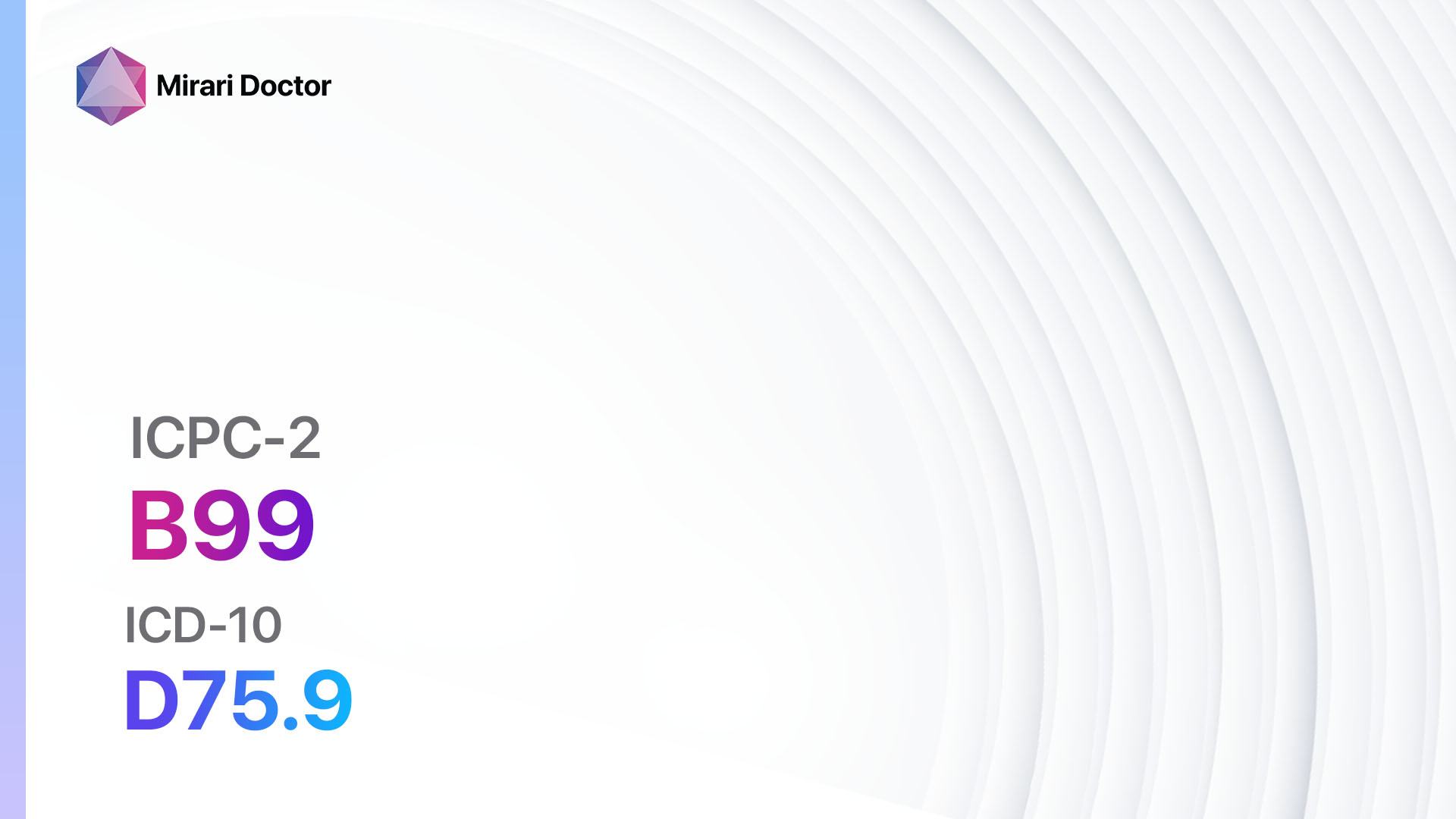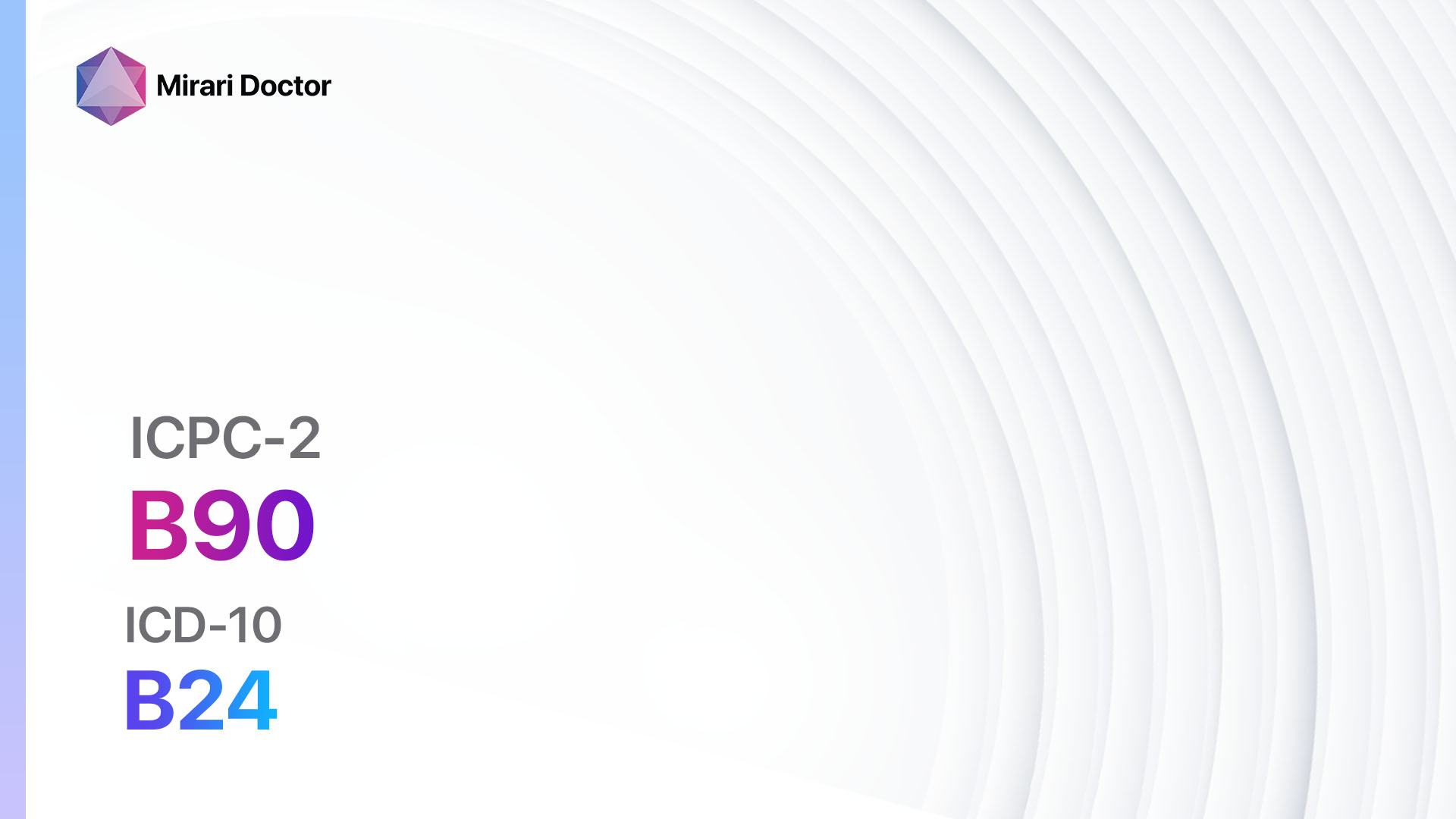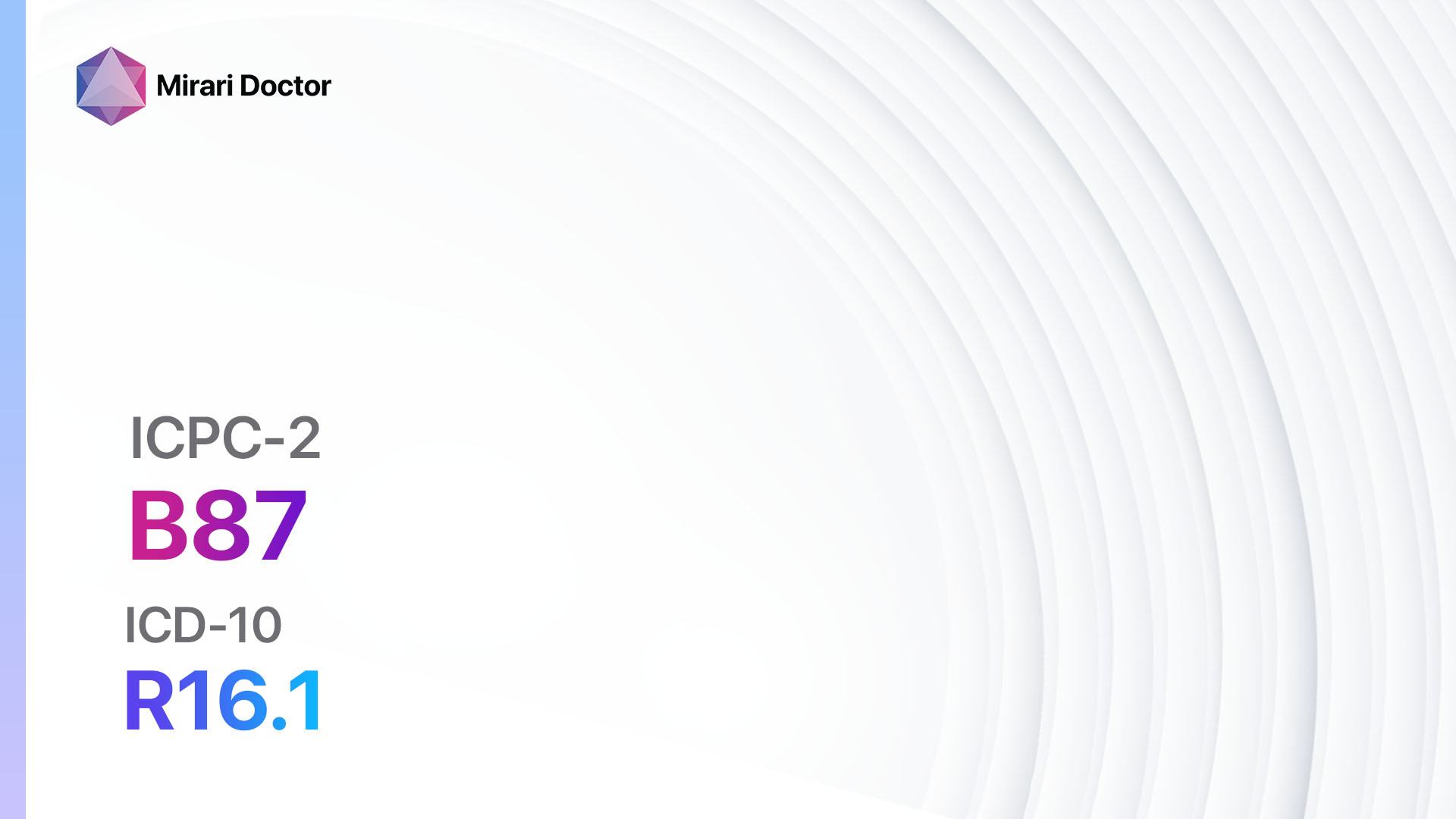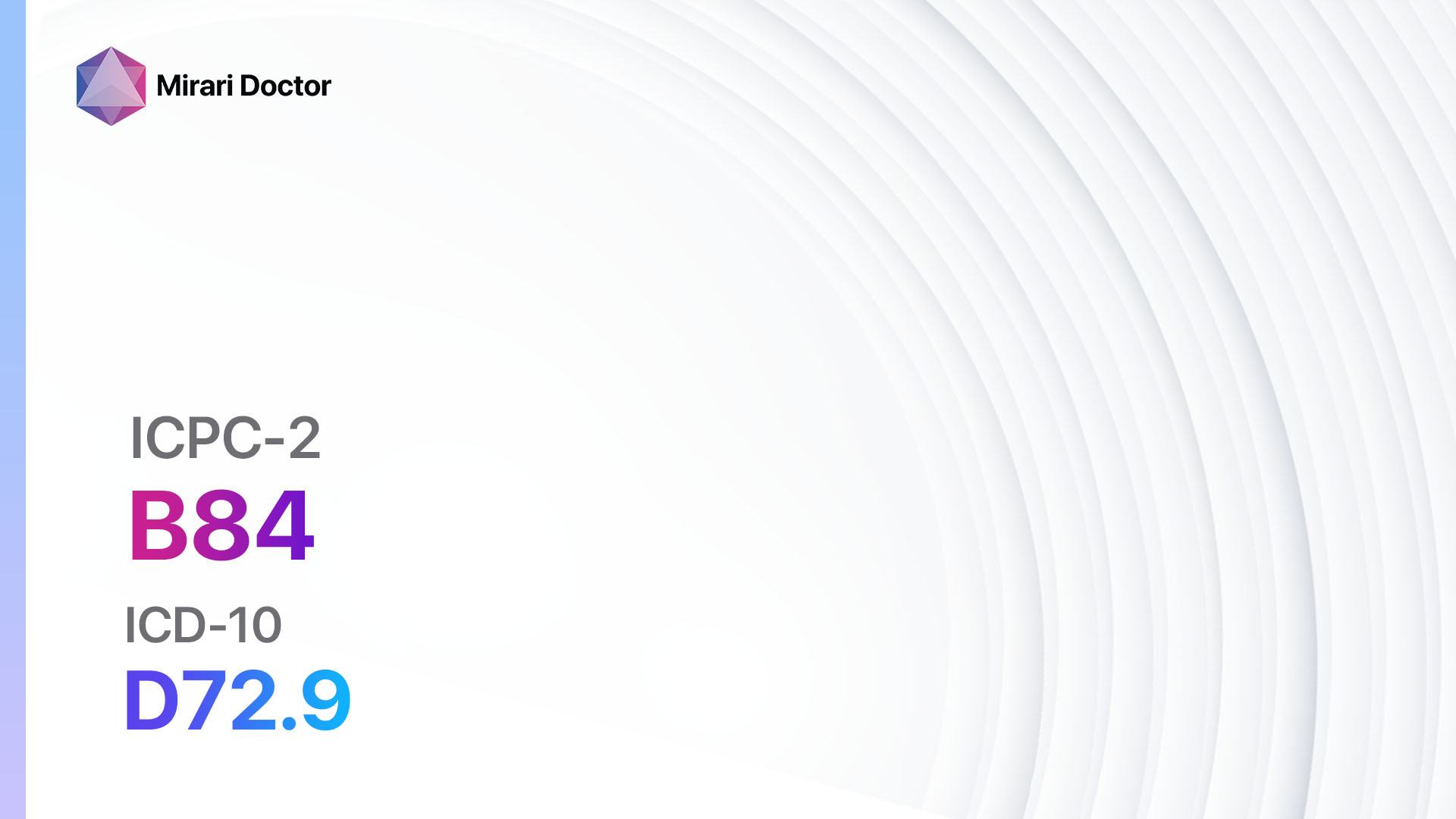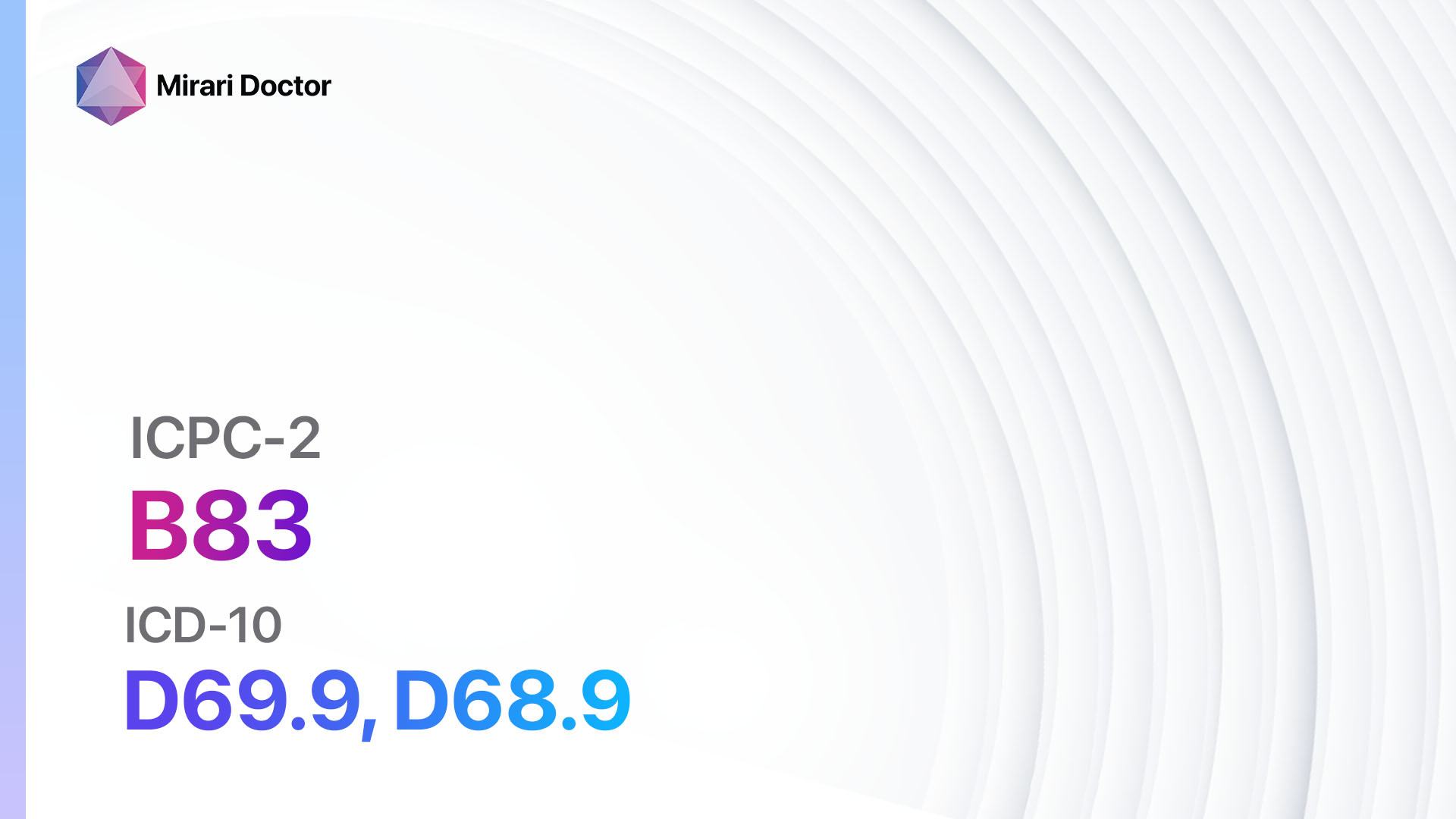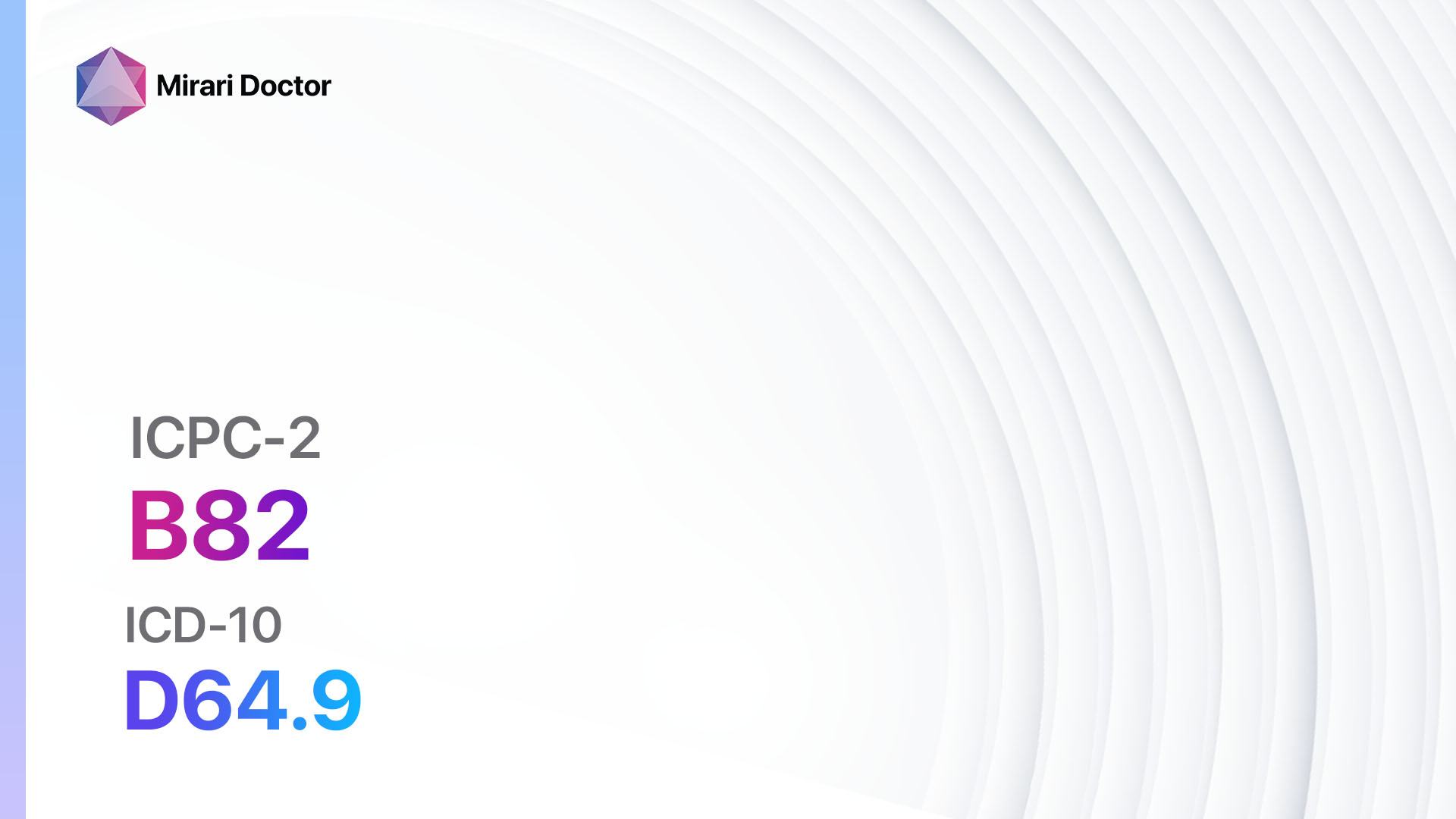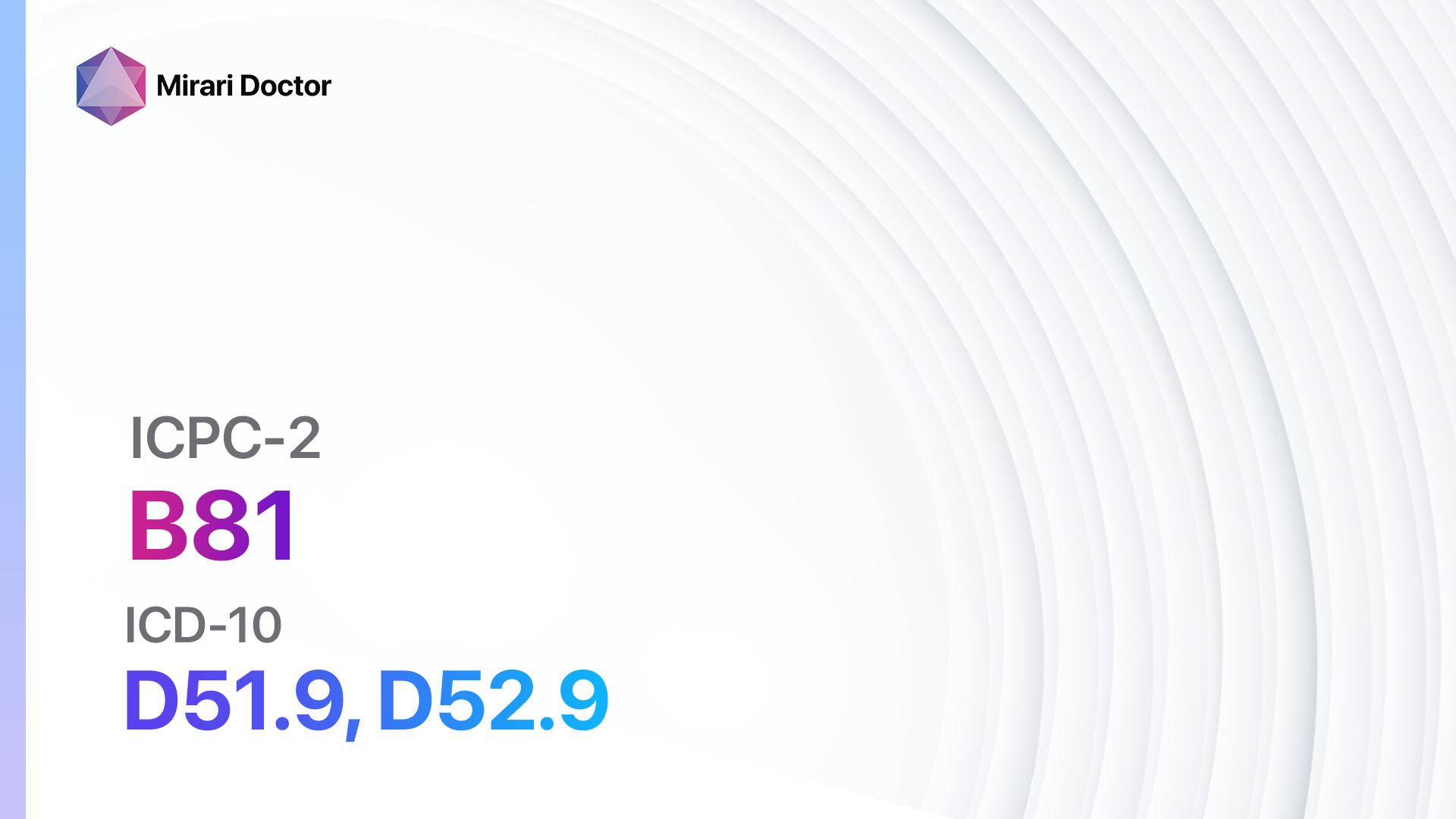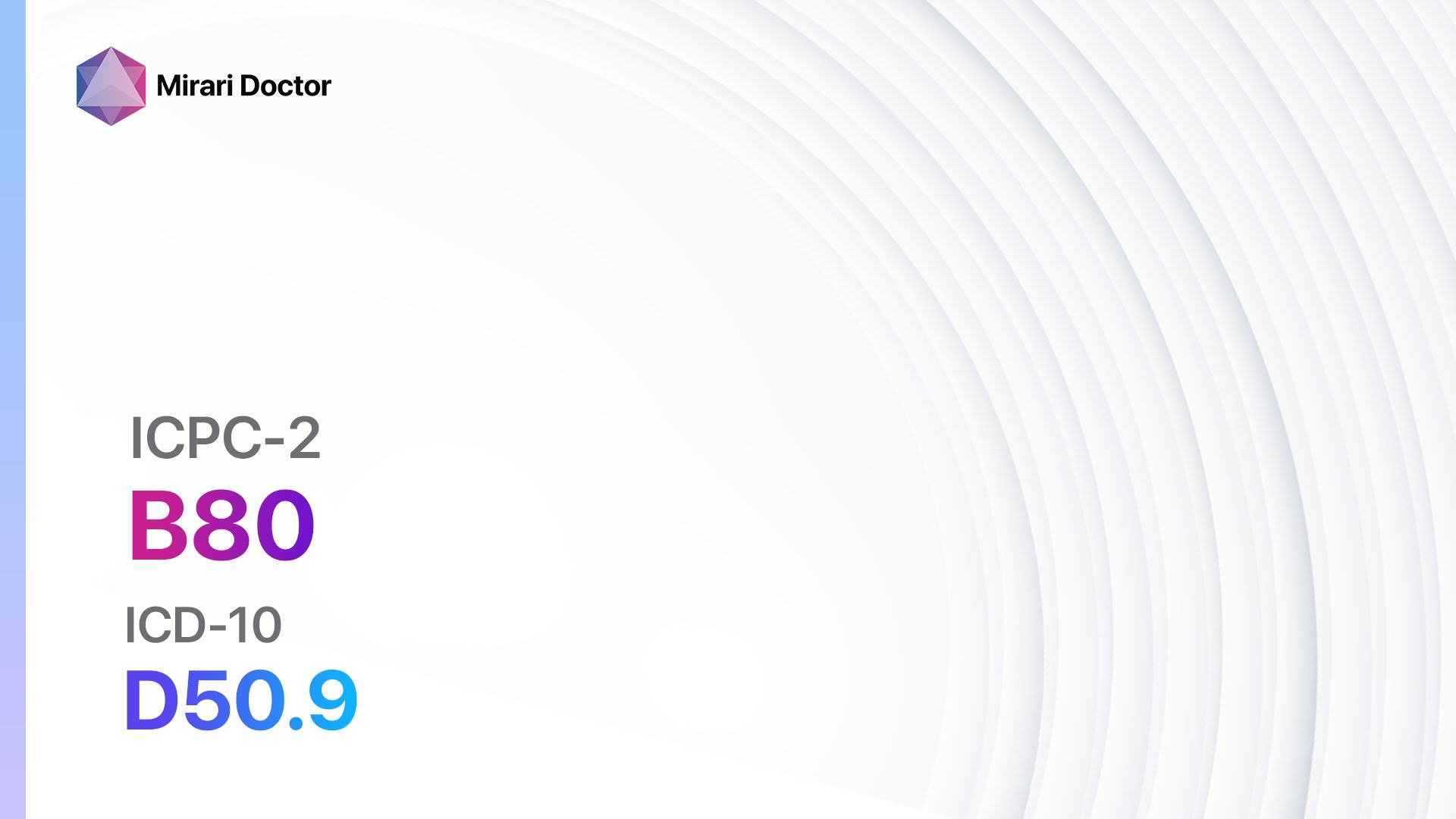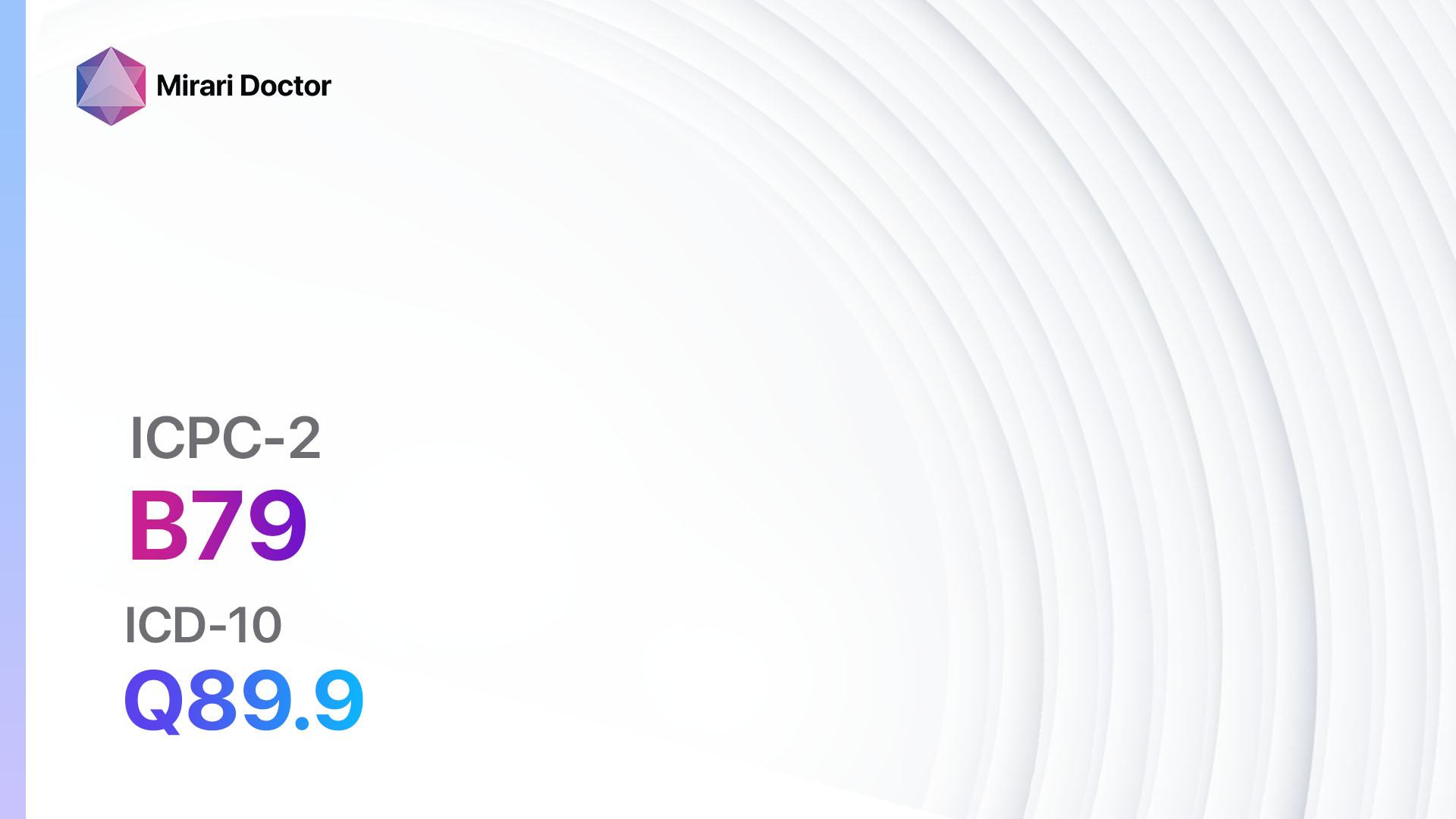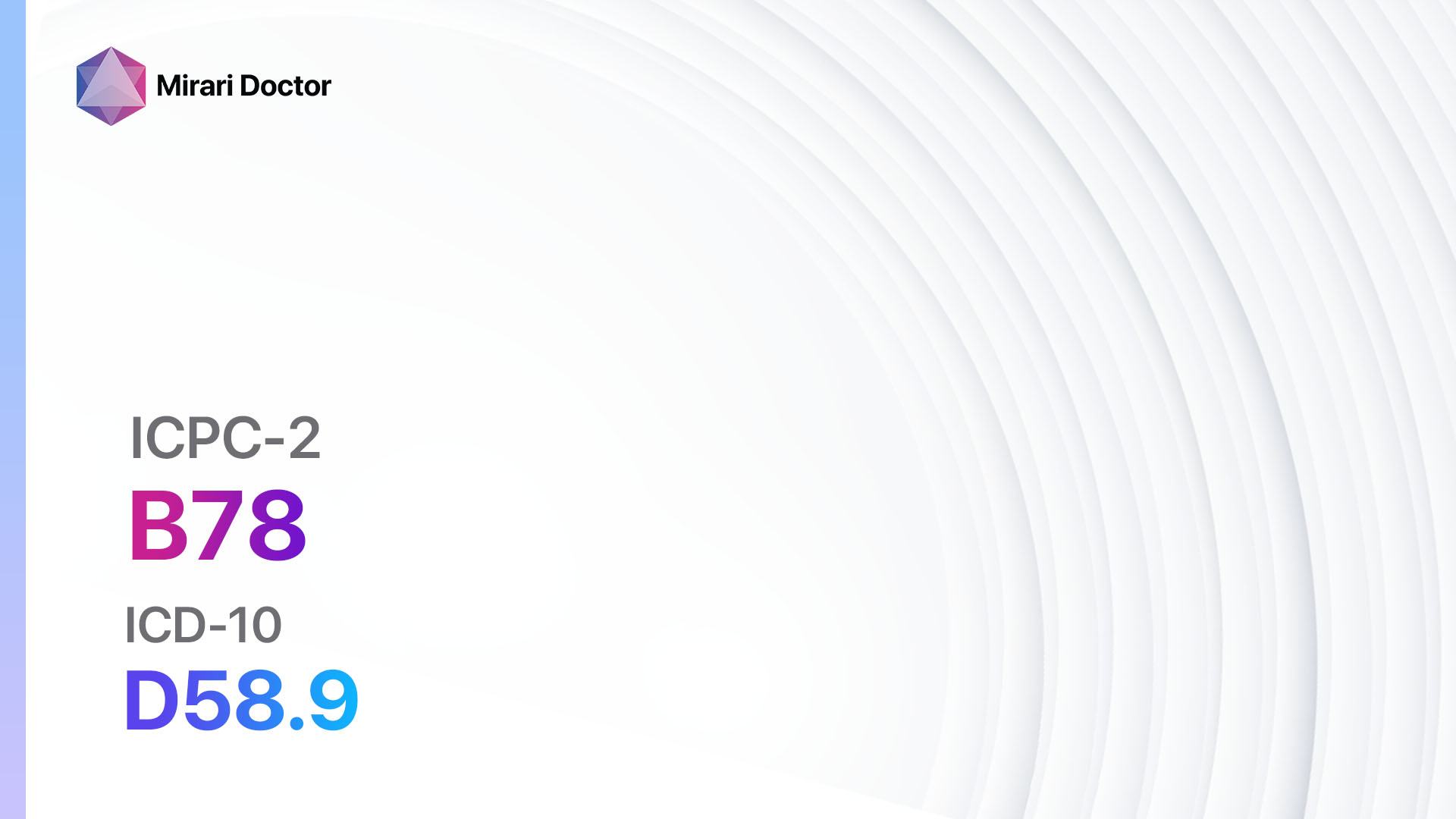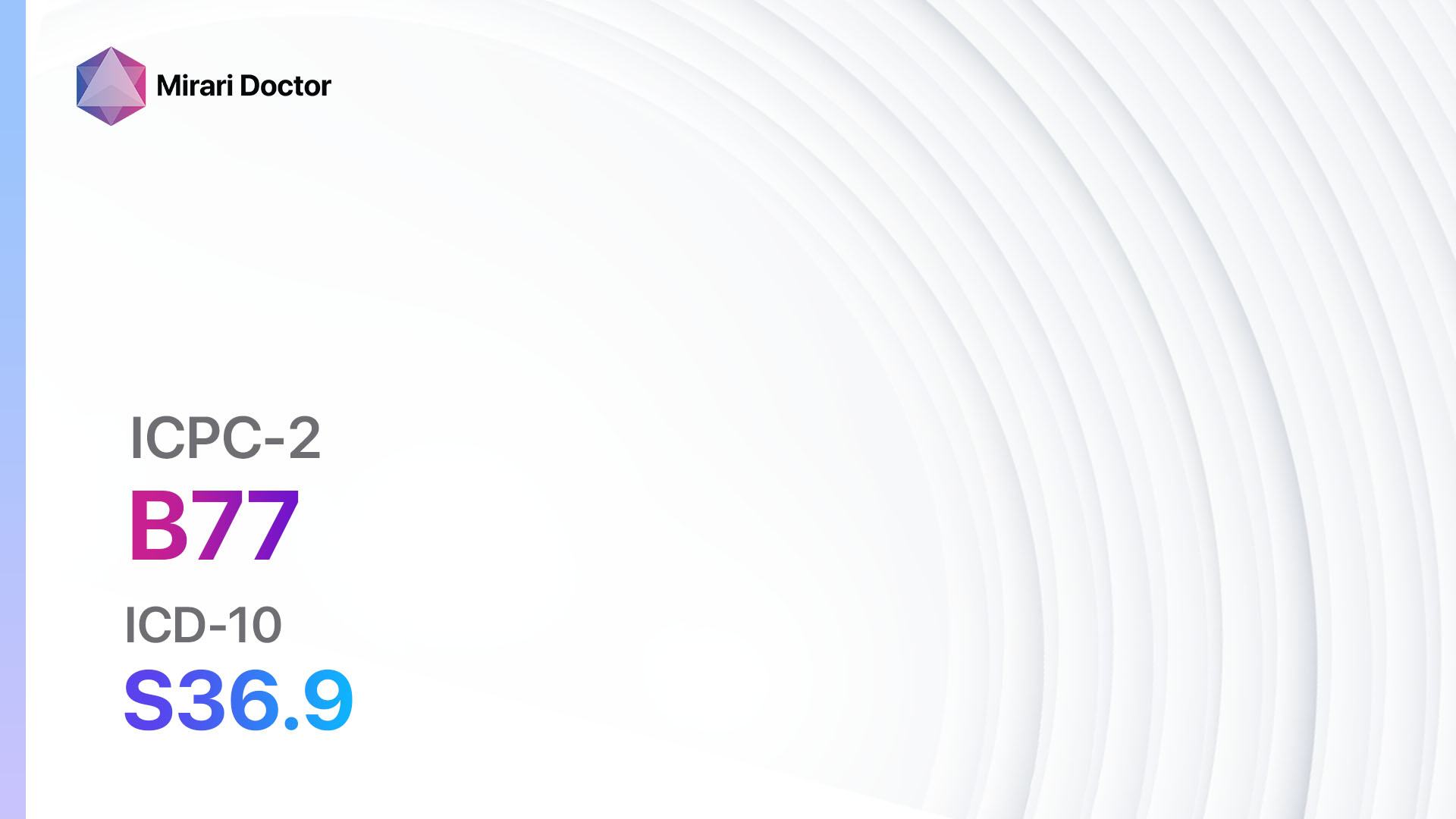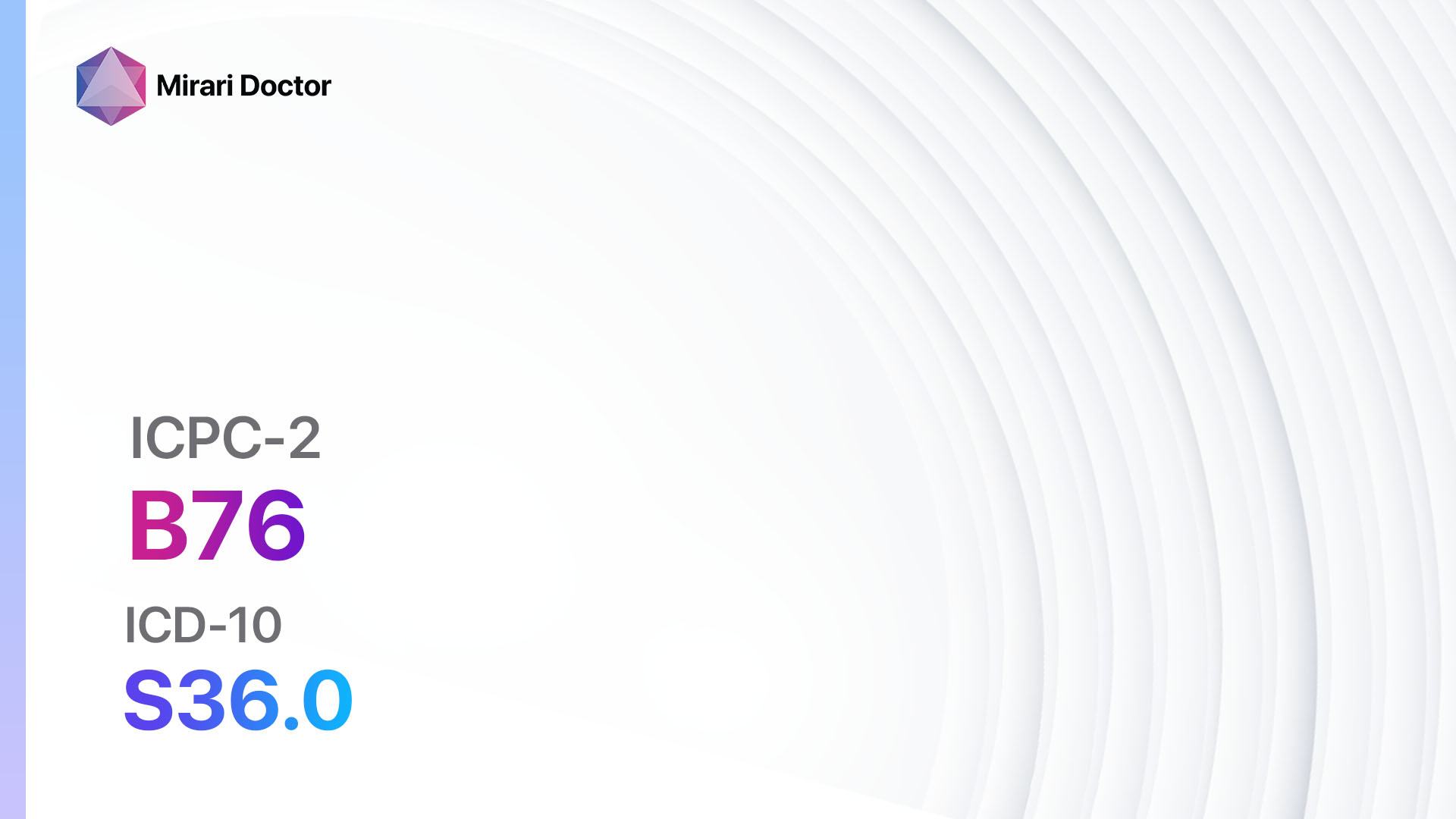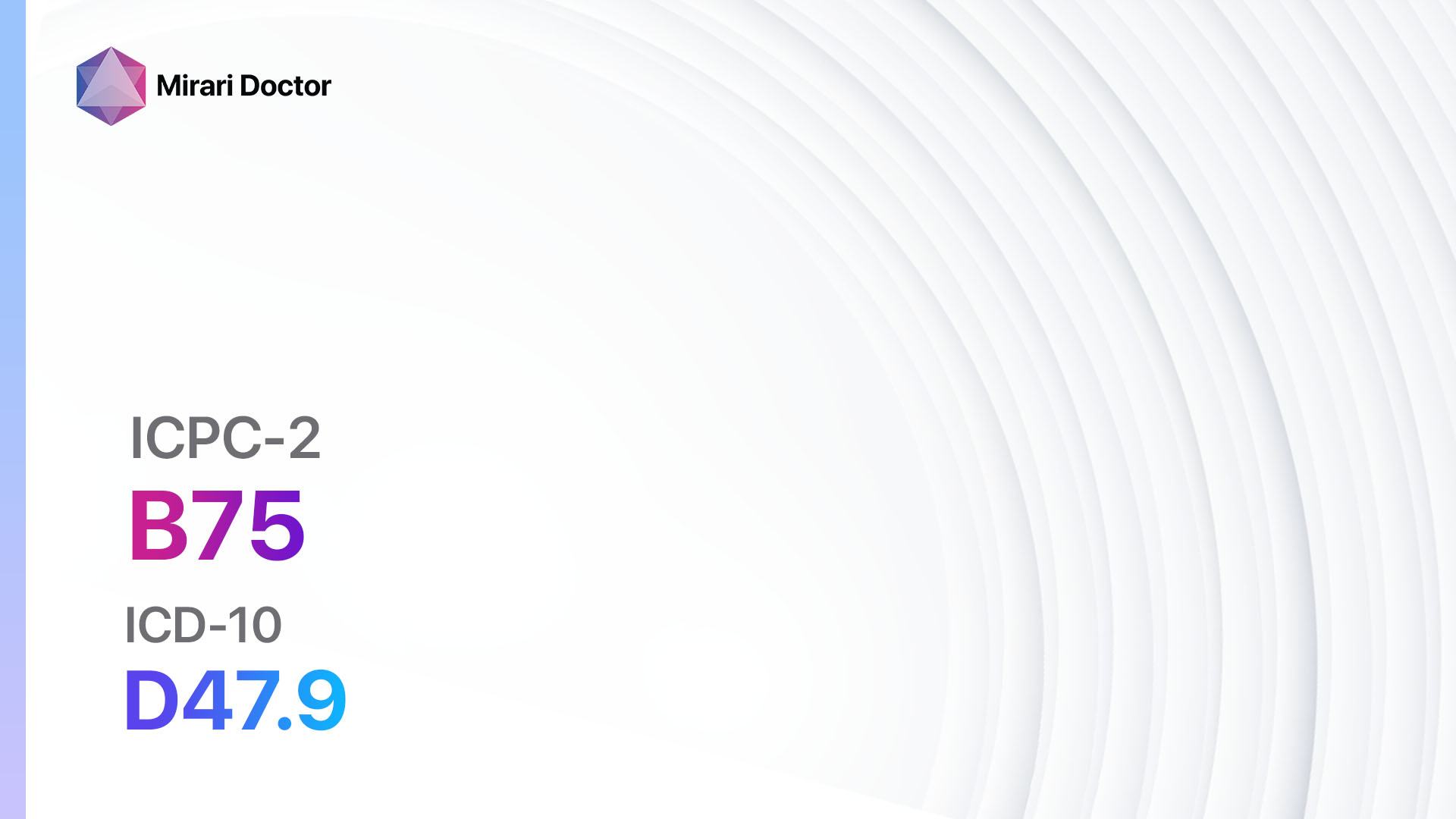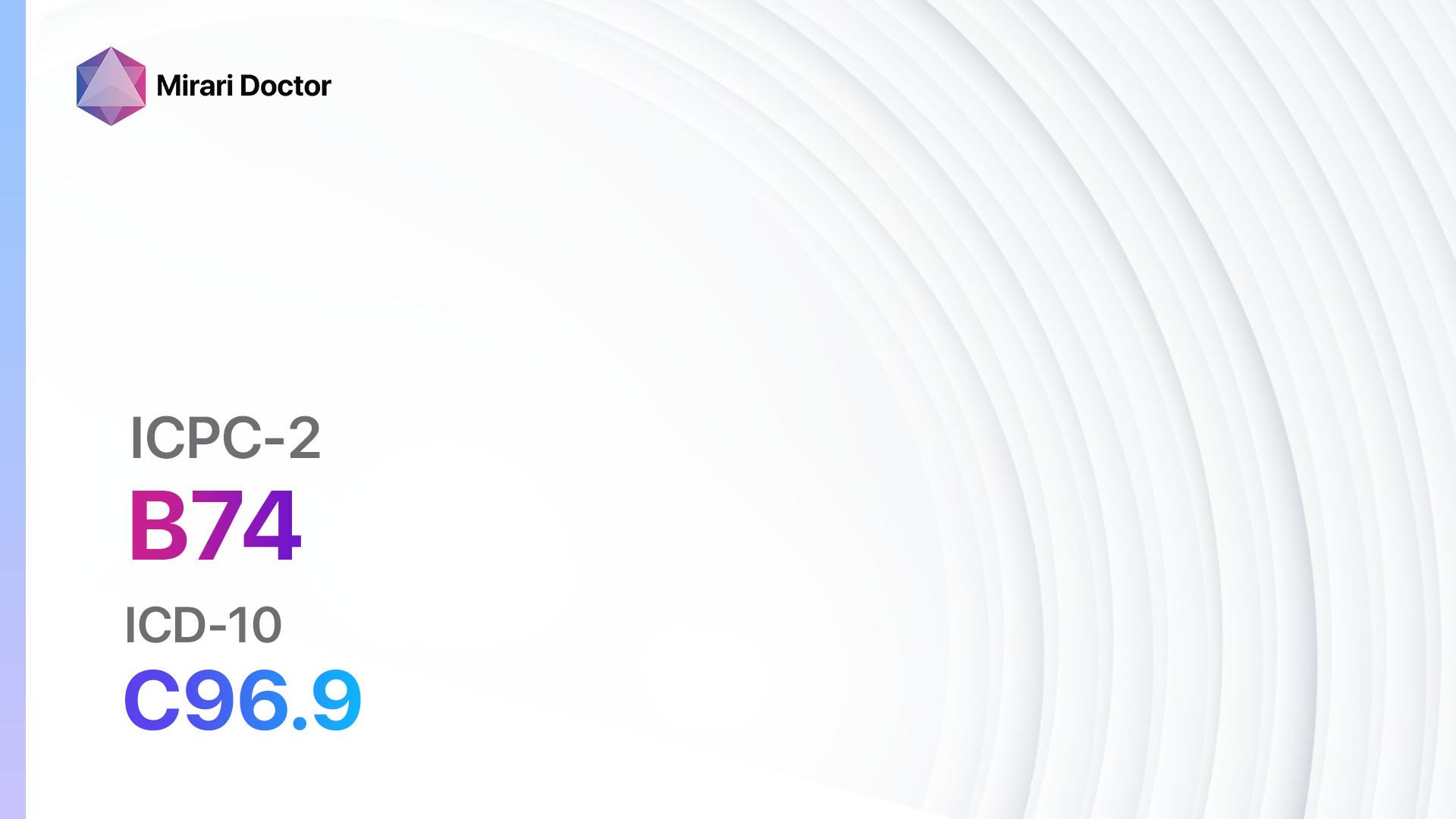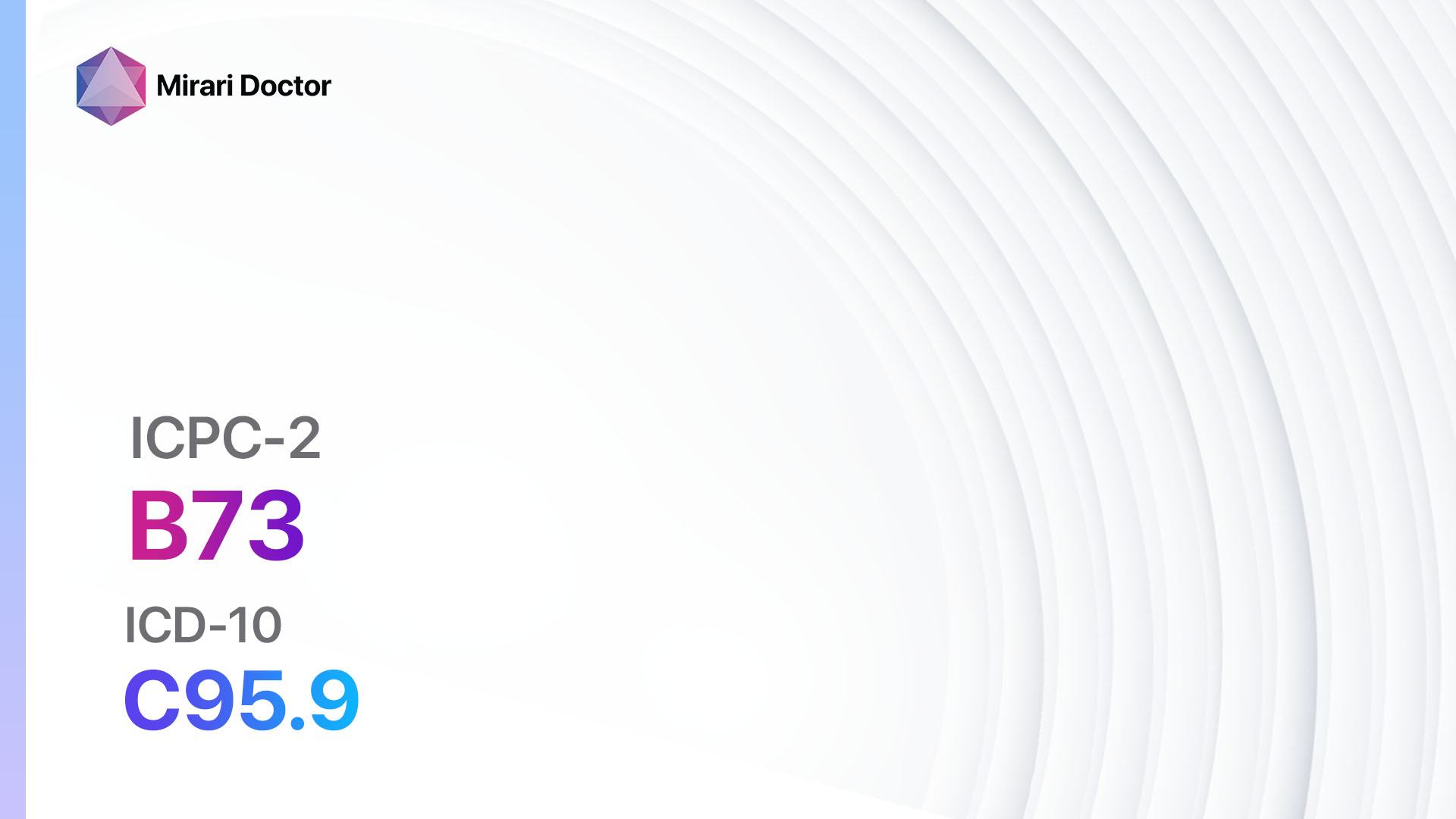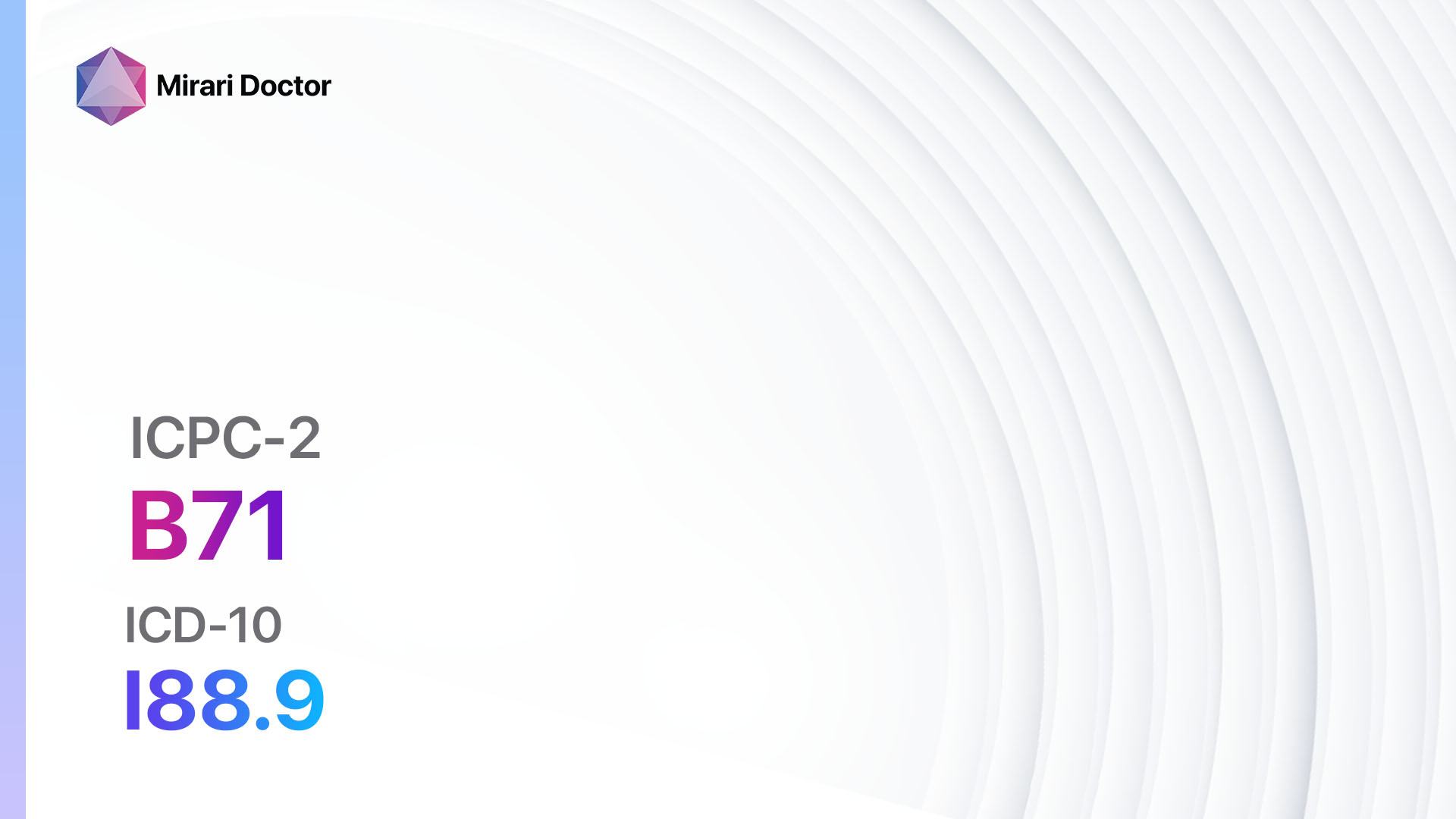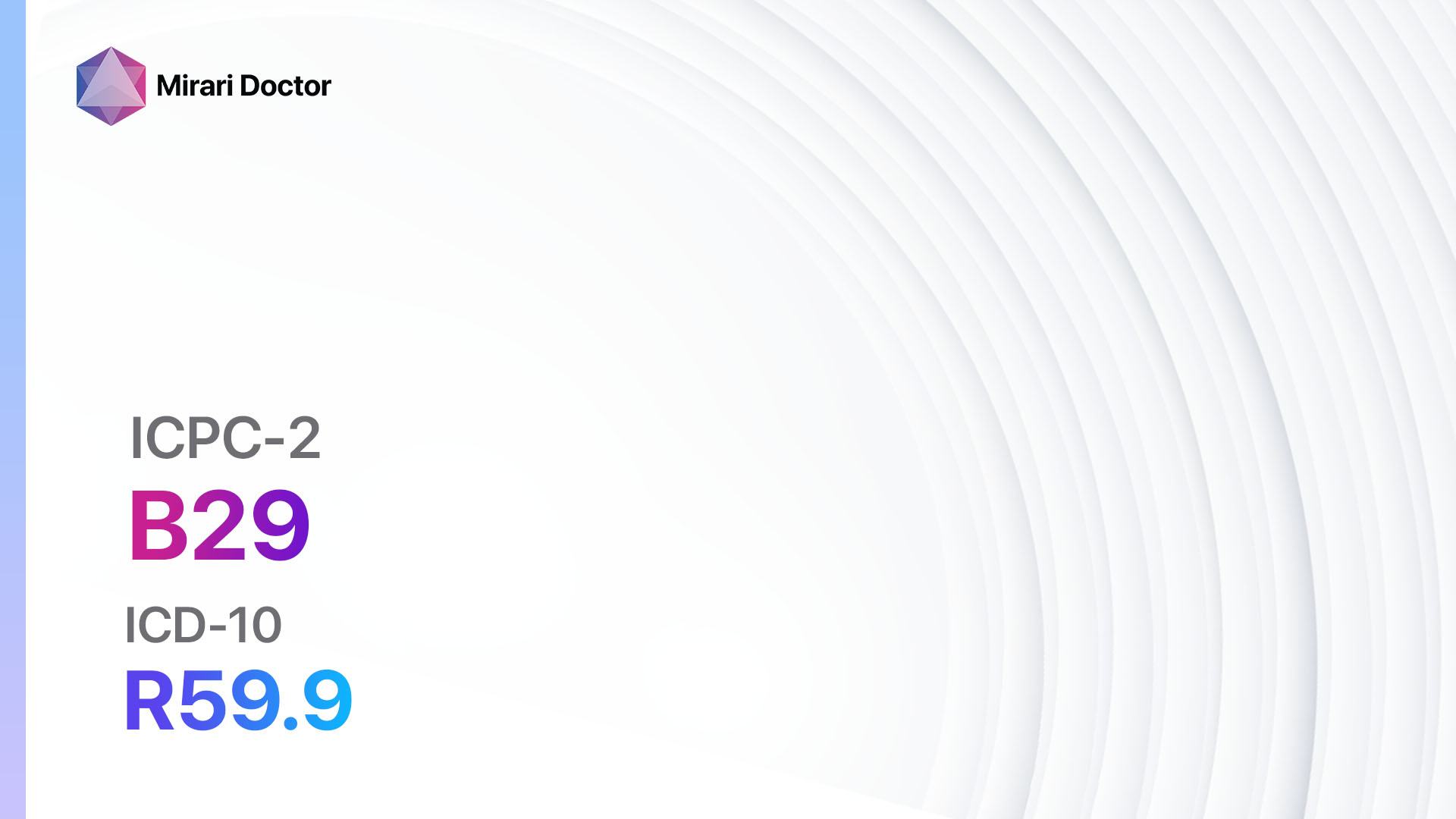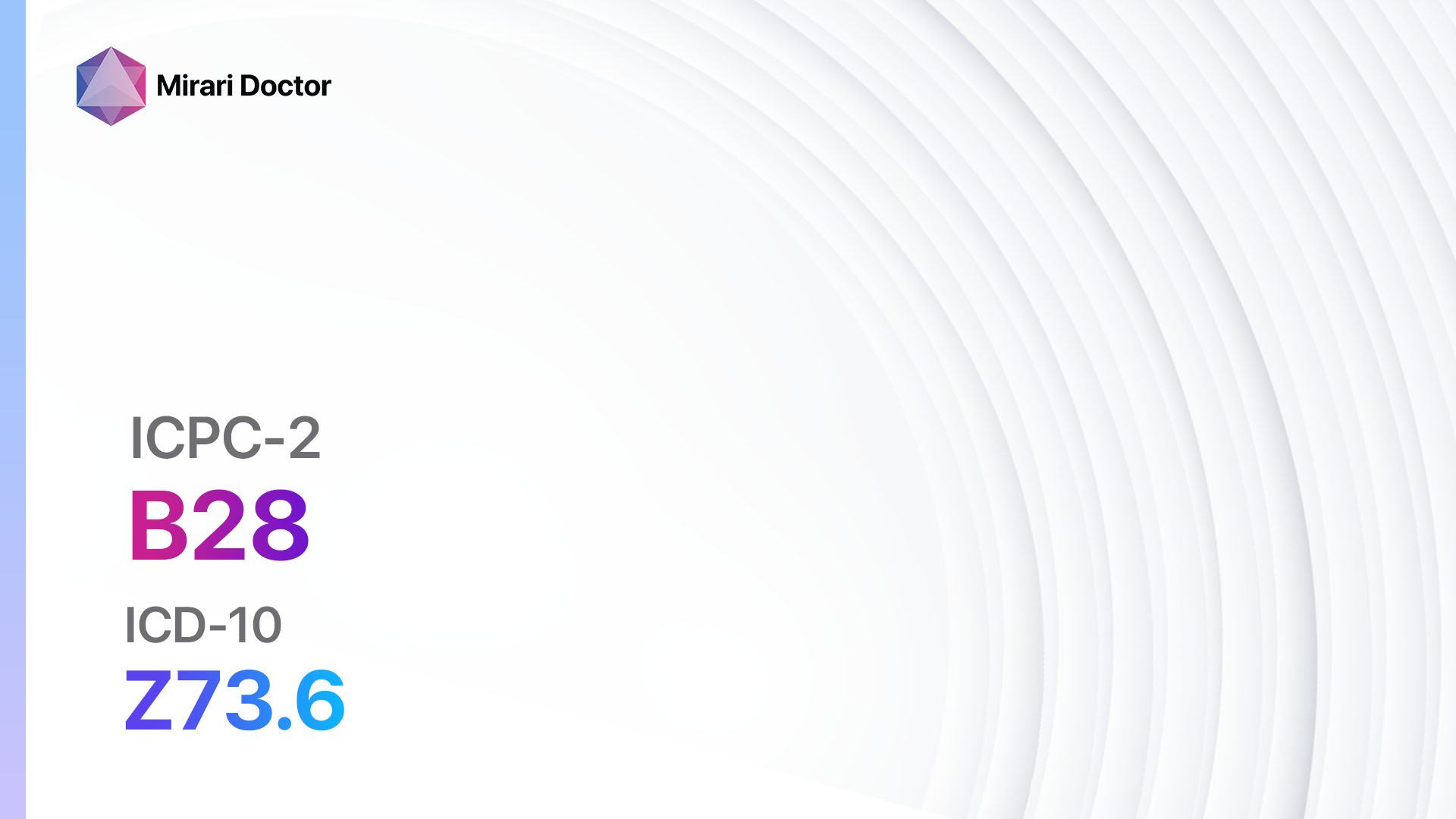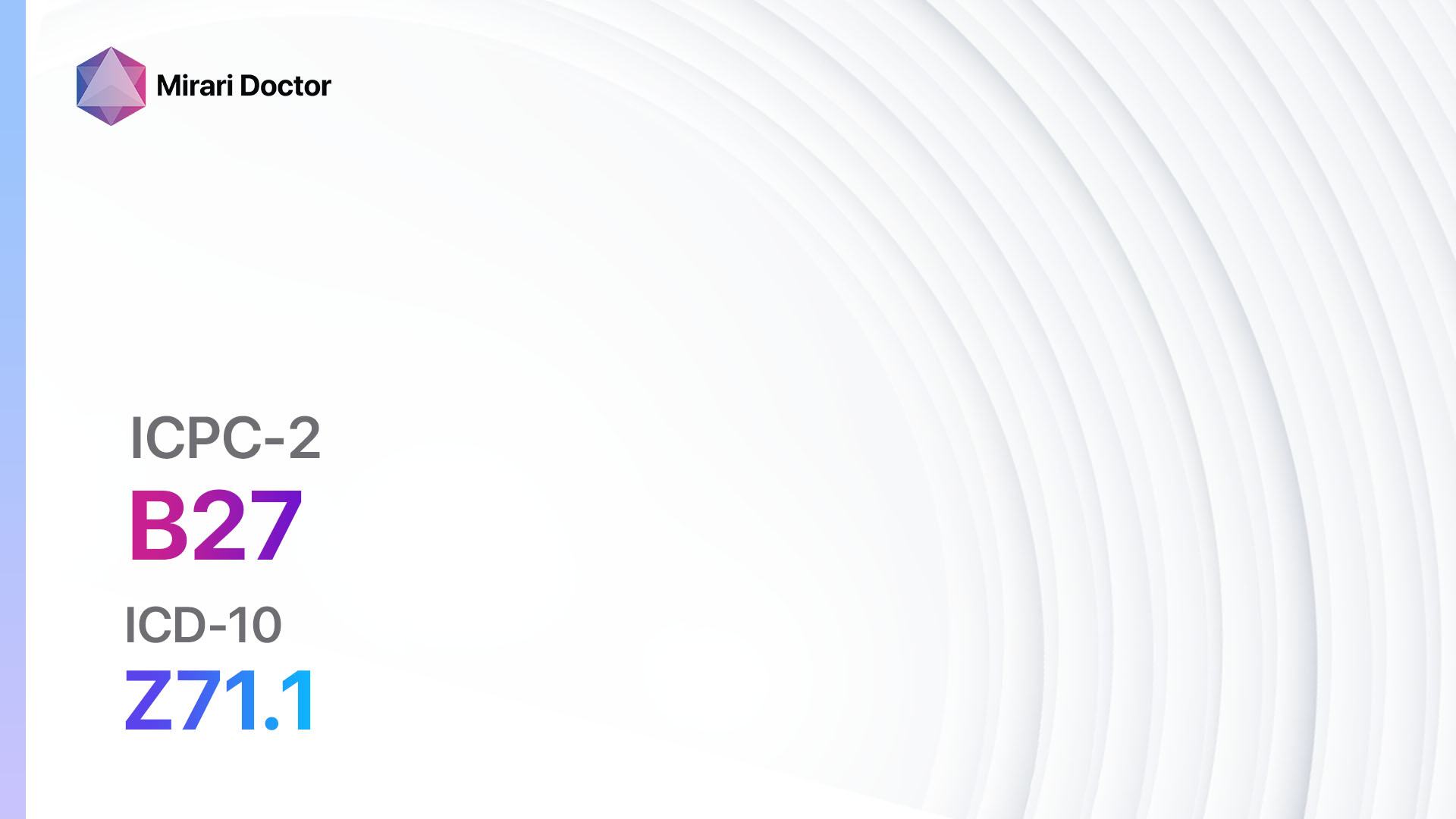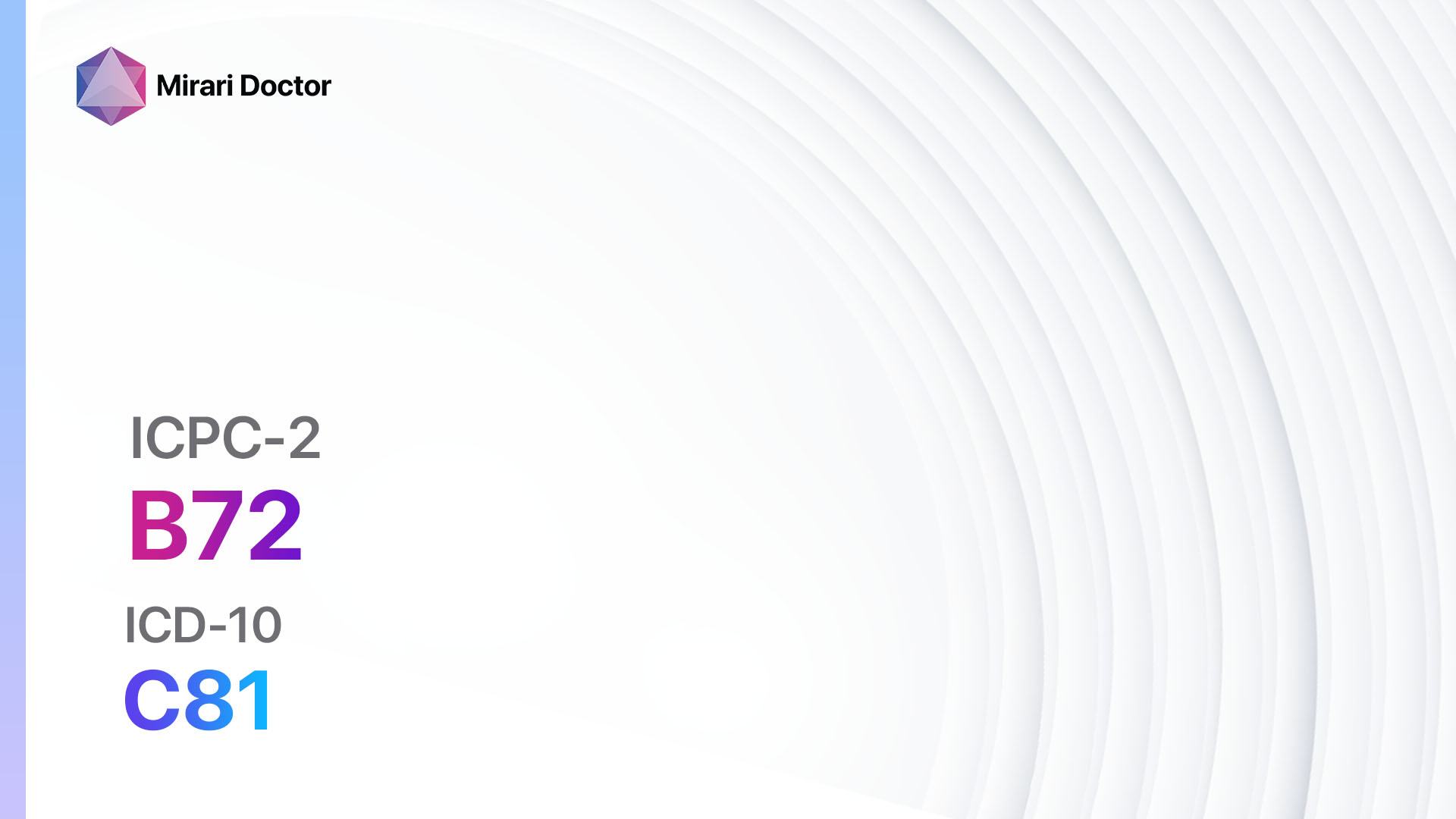
Introduction
Hodgkin’s disease/lymphoma, also known as Hodgkin lymphoma, is a type of cancer that originates in the lymphatic system[1]. It is characterized by the presence of Reed-Sternberg cells, which are large abnormal cells found in the lymph nodes[2]. This condition is significant as it can affect individuals of any age, but it is most commonly diagnosed in young adults between the ages of 15 and 35, as well as in individuals over the age of 55[3]. The aim of this guide is to provide an overview of the symptoms, causes, diagnostic steps, possible interventions, and patient education related to Hodgkin’s disease/lymphoma.
Codes
Symptoms
- Enlarged lymph nodes, usually in the neck, armpits, or groin
- Persistent fatigue
- Unexplained weight loss
- Fever and chills
- Night sweats
- Itchy skin
- Loss of appetite
- Chest pain or coughing
- Shortness of breath
- Pain or swelling in the abdomen
The symptoms of Hodgkin’s disease/lymphoma can vary depending on the stage of the disease and the subtype[6]. It is important to note that these symptoms can also be caused by other conditions, so a proper diagnosis is necessary.
Causes
The exact cause of Hodgkin’s disease/lymphoma is unknown. However, several factors have been identified as potential causes or risk factors:
- Epstein-Barr virus (EBV) infection: Individuals who have been infected with EBV have an increased risk of developing Hodgkin’s disease/lymphoma[7].
- Family history: Having a sibling or parent with Hodgkin’s disease/lymphoma increases the risk of developing the condition[8].
- Weakened immune system: Individuals with a weakened immune system, such as those with HIV/AIDS or those who have undergone an organ transplant, have a higher risk of developing Hodgkin’s disease/lymphoma[9].
- Age and sex: Hodgkin’s disease/lymphoma is more common in young adults and in individuals over the age of 55. It is also slightly more common in males than females[10].
Diagnostic Steps
Medical History
- Gather information about the patient’s symptoms, including the duration and severity.
- Identify any risk factors, such as a family history of Hodgkin’s disease/lymphoma or a history of EBV infection.
- Assess the patient’s overall health and any pre-existing medical conditions.
Physical Examination
- Perform a thorough physical examination, paying particular attention to the lymph nodes, spleen, liver, and other areas where lymph tissue is present.
- Look for signs of enlarged lymph nodes, such as swelling or tenderness.
- Check for other physical signs, such as fever, weight loss, or night sweats.
Laboratory Tests
- Complete blood count (CBC): This test can help identify abnormalities in the blood, such as low red blood cell count (anemia) or abnormal white blood cell count.
- Erythrocyte sedimentation rate (ESR): Elevated ESR levels may indicate inflammation or infection.
- Liver function tests: These tests can assess the functioning of the liver, which may be affected by Hodgkin’s disease/lymphoma.
- Kidney function tests: These tests can evaluate the functioning of the kidneys, which may be affected by the disease or its treatment.
- Blood chemistry tests: These tests can provide information about the overall health of the patient, including electrolyte levels and organ function.
Diagnostic Imaging
- Chest X-ray: This imaging modality can help identify any abnormalities in the chest, such as enlarged lymph nodes or tumors.
- Computed tomography (CT) scan: A CT scan can provide detailed images of the chest, abdomen, and pelvis, allowing for a more accurate assessment of the extent of the disease.
- Positron emission tomography (PET) scan: A PET scan can help determine the metabolic activity of the lymphoma cells and identify areas of the body affected by the disease.
- Magnetic resonance imaging (MRI): An MRI can provide detailed images of the lymph nodes and surrounding tissues, helping to assess the stage and extent of the disease.
Other Tests
- Lymph node biopsy: A biopsy of an enlarged lymph node is necessary to confirm the diagnosis of Hodgkin’s disease/lymphoma. This can be done through a needle biopsy or a surgical biopsy.
- Bone marrow biopsy: This test may be performed to determine if the disease has spread to the bone marrow.
- Immunophenotyping: This test can help identify the specific type of lymphoma cells present in the biopsy sample.
- Genetic testing: Genetic testing may be performed to identify specific genetic mutations associated with Hodgkin’s disease/lymphoma.
Follow-up and Patient Education
- After a diagnosis of Hodgkin’s disease/lymphoma, regular follow-up appointments will be necessary to monitor the patient’s response to treatment and assess for any recurrence of the disease.
- Patient education should focus on the importance of adhering to the prescribed treatment plan, managing side effects, and maintaining overall health and well-being.
Possible Interventions
Traditional Interventions
Medications:
Top 5 drugs for Hodgkin’s disease/lymphoma:
- ABVD chemotherapy regimen (Adriamycin, Bleomycin, Vinblastine, Dacarbazine):
- Cost: Varies depending on the specific drugs and dosage used.
- Contraindications: Hypersensitivity to any of the drugs in the regimen.
- Side effects: Nausea, vomiting, hair loss, fatigue.
- Severe side effects: Cardiotoxicity, lung toxicity, secondary cancers.
- Drug interactions: Many potential drug interactions, so a thorough medication review is necessary.
- Warning: Regular monitoring of blood counts and cardiac function is required.
- BEACOPP chemotherapy regimen (Bleomycin, Etoposide, Adriamycin, Cyclophosphamide, Vincristine, Procarbazine, Prednisone):
- Cost: Varies depending on the specific drugs and dosage used.
- Contraindications: Hypersensitivity to any of the drugs in the regimen.
- Side effects: Nausea, vomiting, hair loss, fatigue.
- Severe side effects: Cardiotoxicity, lung toxicity, secondary cancers.
- Drug interactions: Many potential drug interactions, so a thorough medication review is necessary.
- Warning: Regular monitoring of blood counts and cardiac function is required.
- Brentuximab vedotin (Adcetris):
- Cost: Approximately $16,000 per vial.
- Contraindications: Hypersensitivity to brentuximab vedotin or any of its components.
- Side effects: Nausea, fatigue, peripheral neuropathy.
- Severe side effects: Pulmonary toxicity, hepatotoxicity, peripheral neuropathy.
- Drug interactions: None reported.
- Warning: Regular monitoring of blood counts and liver function is required.
- Nivolumab (Opdivo):
- Cost: Approximately $12,000 per vial.
- Contraindications: Hypersensitivity to nivolumab or any of its components.
- Side effects: Fatigue, rash, diarrhea.
- Severe side effects: Immune-mediated pneumonitis, colitis, hepatitis.
- Drug interactions: None reported.
- Warning: Regular monitoring of liver function and immune-related adverse events is required.
- Brentuximab vedotin and nivolumab combination therapy:
- Cost: Varies depending on the specific drugs and dosage used.
- Contraindications: Hypersensitivity to brentuximab vedotin, nivolumab, or any of their components.
- Side effects: Nausea, fatigue, peripheral neuropathy, rash.
- Severe side effects: Pulmonary toxicity, hepatotoxicity, peripheral neuropathy, immune-mediated adverse events.
- Drug interactions: None reported.
- Warning: Regular monitoring of blood counts, liver function, and immune-related adverse events is required.
Alternative Drugs:
- Bleomycin, etoposide, doxorubicin, cyclophosphamide, vincristine, procarbazine, and prednisone (BEACOPP) regimen: An alternative chemotherapy regimen that may be used in certain cases.
- Doxorubicin, bleomycin, vinblastine, and dacarbazine (ABVD) regimen: Another chemotherapy regimen that may be used in certain cases.
- Radiation therapy: Radiation therapy may be used in combination with chemotherapy or as a standalone treatment for localized disease.
- Stem cell transplant: A stem cell transplant may be considered for patients with relapsed or refractory disease.
Surgical Procedures:
- Splenectomy: In rare cases, a splenectomy may be performed to remove an enlarged spleen that is causing discomfort or other complications.
- Lymph node biopsy: A lymph node biopsy may be performed to obtain a tissue sample for diagnosis or to assess the response to treatment.
Alternative Interventions
- Acupuncture: May help manage treatment-related side effects, such as nausea and fatigue. Cost: $60-$120 per session.
- Mind-body techniques: Techniques such as meditation, yoga, or tai chi may help reduce stress and improve overall well-being. Cost: Varies depending on the specific practice.
- Herbal supplements: Some herbal supplements, such as curcumin or green tea extract, may have potential benefits in managing symptoms or supporting immune function. Cost: Varies depending on the specific supplement.
- Dietary modifications: A healthy diet rich in fruits, vegetables, and whole grains may help support overall health and well-being. Cost: Varies depending on individual dietary choices.
- Exercise: Regular physical activity can help improve energy levels, reduce fatigue, and support overall health. Cost: Varies depending on individual preferences and access to exercise facilities.
Lifestyle Interventions
- Stress management: Techniques such as deep breathing, meditation, or mindfulness can help reduce stress and support overall well-being. Cost: Varies depending on the specific practice.
- Healthy diet: A balanced diet rich in fruits, vegetables, whole grains, and lean proteins can support overall health and well-being. Cost: Varies depending on individual dietary choices.
- Regular exercise: Engaging in regular physical activity can help improve energy levels, reduce fatigue, and support overall health. Cost: Varies depending on individual preferences and access to exercise facilities.
- Adequate sleep: Getting enough sleep is important for overall health and well-being. Cost: Varies depending on individual sleep habits and preferences.
- Avoidance of tobacco and alcohol: Tobacco and alcohol use can have negative effects on overall health and may increase the risk of complications. Cost: Varies depending on individual habits and preferences.
It is important to note that the cost ranges provided are approximate and may vary depending on the location and availability of the interventions.
Mirari Cold Plasma Alternative Intervention
Understanding Mirari Cold Plasma
- Safe and Non-Invasive Treatment: Mirari Cold Plasma is a safe and non-invasive treatment option for various skin conditions. It does not require incisions, minimizing the risk of scarring, bleeding, or tissue damage.
- Efficient Extraction of Foreign Bodies: Mirari Cold Plasma facilitates the removal of foreign bodies from the skin by degrading and dissociating organic matter, allowing easier access and extraction.
- Pain Reduction and Comfort: Mirari Cold Plasma has a local analgesic effect, providing pain relief during the treatment, making it more comfortable for the patient.
- Reduced Risk of Infection: Mirari Cold Plasma has antimicrobial properties, effectively killing bacteria and reducing the risk of infection.
- Accelerated Healing and Minimal Scarring: Mirari Cold Plasma stimulates wound healing and tissue regeneration, reducing healing time and minimizing the formation of scars.
Mirari Cold Plasma Prescription
Video instructions for using Mirari Cold Plasma Device – B72 Hodgkin’s disease/lymphoma (ICD-10:C81)
| Mild | Moderate | Severe |
| Mode setting: 1 (Infection) Location: 0 (Localized) Morning: 15 minutes, Evening: 15 minutes |
Mode setting: 1 (Infection) Location: 0 (Localized) Morning: 30 minutes, Lunch: 30 minutes, Evening: 30 minutes |
Mode setting: 1 (Infection) Location: 0 (Localized) Morning: 30 minutes, Lunch: 30 minutes, Evening: 30 minutes |
| Mode setting: 2 (Wound Healing) Location: 0 (Localized) Morning: 15 minutes, Evening: 15 minutes |
Mode setting: 2 (Wound Healing) Location: 0 (Localized) Morning: 30 minutes, Lunch: 30 minutes, Evening: 30 minutes |
Mode setting: 2 (Wound Healing) Location: 0 (Localized) Morning: 30 minutes, Lunch: 30 minutes, Evening: 30 minutes |
| Mode setting: 3 (Antiviral Therapy) Location: 0 (Localized) Morning: 15 minutes, Evening: 15 minutes |
Mode setting: 3 (Antiviral Therapy) Location: 0 (Localized) Morning: 30 minutes, Lunch: 30 minutes, Evening: 30 minutes |
Mode setting: 3 (Antiviral Therapy) Location: 0 (Localized) Morning: 30 minutes, Lunch: 30 minutes, Evening: 30 minutes |
| Mode setting: 7 (Immunotherapy) Location: 1 (Sacrum) Morning: 15 minutes, Evening: 15 minutes |
Mode setting: 7 (Immunotherapy) Location: 1 (Sacrum) Morning: 30 minutes, Lunch: 30 minutes, Evening: 30 minutes |
Mode setting: 7 (Immunotherapy) Location: 1 (Sacrum) Morning: 30 minutes, Lunch: 30 minutes, Evening: 30 minutes |
| Total Morning: 60 minutes approx. $10 USD, Evening: 60 minutes approx. $10 USD |
Total Morning: 120 minutes approx. $20 USD, Lunch: 120 minutes approx. $20 USD, Evening: 120 minutes approx. $20 USD, |
Total Morning: 120 minutes approx. $20 USD, Lunch: 120 minutes approx. $20 USD, Evening: 120 minutes approx. $20 USD, |
| Usual treatment for 7-60 days approx. $140 USD – $1200 USD | Usual treatment for 6-8 weeks approx. $2,520 USD – $3,360 USD |
Usual treatment for 3-6 months approx. $5,400 USD – $10,800 USD
|
 |
|
Use the Mirari Cold Plasma device to treat Hodgkin’s disease/lymphoma effectively.
WARNING: MIRARI COLD PLASMA IS DESIGNED FOR THE HUMAN BODY WITHOUT ANY ARTIFICIAL OR THIRD PARTY PRODUCTS. USE OF OTHER PRODUCTS IN COMBINATION WITH MIRARI COLD PLASMA MAY CAUSE UNPREDICTABLE EFFECTS, HARM OR INJURY. PLEASE CONSULT A MEDICAL PROFESSIONAL BEFORE COMBINING ANY OTHER PRODUCTS WITH USE OF MIRARI.
Step 1: Cleanse the Skin
- Start by cleaning the affected area of the skin with a gentle cleanser or mild soap and water. Gently pat the area dry with a clean towel.
Step 2: Prepare the Mirari Cold Plasma device
- Ensure that the Mirari Cold Plasma device is fully charged or has fresh batteries as per the manufacturer’s instructions. Make sure the device is clean and in good working condition.
- Switch on the Mirari device using the power button or by following the specific instructions provided with the device.
- Some Mirari devices may have adjustable settings for intensity or treatment duration. Follow the manufacturer’s instructions to select the appropriate settings based on your needs and the recommended guidelines.
Step 3: Apply the Device
- Place the Mirari device in direct contact with the affected area of the skin. Gently glide or hold the device over the skin surface, ensuring even coverage of the area experiencing.
- Slowly move the Mirari device in a circular motion or follow a specific pattern as indicated in the user manual. This helps ensure thorough treatment coverage.
Step 4: Monitor and Assess:
- Keep track of your progress and evaluate the effectiveness of the Mirari device in managing your Hodgkin’s disease/lymphoma. If you have any concerns or notice any adverse reactions, consult with your health care professional.
Note
This guide is for informational purposes only and should not replace the advice of a medical professional. Always consult with your healthcare provider or a qualified medical professional for personal advice, diagnosis, or treatment. Do not solely rely on the information presented here for decisions about your health. Use of this information is at your own risk. The authors of this guide, nor any associated entities or platforms, are not responsible for any potential adverse effects or outcomes based on the content.
Mirari Cold Plasma System Disclaimer
- Purpose: The Mirari Cold Plasma System is a Class 2 medical device designed for use by trained healthcare professionals. It is registered for use in Thailand and Vietnam. It is not intended for use outside of these locations.
- Informational Use: The content and information provided with the device are for educational and informational purposes only. They are not a substitute for professional medical advice or care.
- Variable Outcomes: While the device is approved for specific uses, individual outcomes can differ. We do not assert or guarantee specific medical outcomes.
- Consultation: Prior to utilizing the device or making decisions based on its content, it is essential to consult with a Certified Mirari Tele-Therapist and your medical healthcare provider regarding specific protocols.
- Liability: By using this device, users are acknowledging and accepting all potential risks. Neither the manufacturer nor the distributor will be held accountable for any adverse reactions, injuries, or damages stemming from its use.
- Geographical Availability: This device has received approval for designated purposes by the Thai and Vietnam FDA. As of now, outside of Thailand and Vietnam, the Mirari Cold Plasma System is not available for purchase or use.
References
- Shanbhag, S., & Ambinder, R. F. (2018). Hodgkin lymphoma: A review and update on recent progress. CA: A Cancer Journal for Clinicians, 68(2), 116-132. https://doi.org/10.3322/caac.21438
- Küppers, R., Engert, A., & Hansmann, M. L. (2012). Hodgkin lymphoma. The Journal of Clinical Investigation, 122(10), 3439-3447. https://doi.org/10.1172/JCI61245
- Shenoy, P., Maggioncalda, A., Malik, N., & Flowers, C. R. (2011). Incidence patterns and outcomes for Hodgkin lymphoma patients in the United States. Advances in Hematology, 2011, 725219. https://doi.org/10.1155/2011/725219
- WONCA International Classification Committee. (2005). ICPC-2-R: International Classification of Primary Care (2nd ed., revised). Oxford University Press.
- World Health Organization. (2019). International Statistical Classification of Diseases and Related Health Problems (11th ed.). https://icd.who.int/
- Ansell, S. M. (2015). Hodgkin lymphoma: Diagnosis and treatment. Mayo Clinic Proceedings, 90(11), 1574-1583. https://doi.org/10.1016/j.mayocp.2015.07.005
- Hjalgrim, H., Askling, J., Rostgaard, K., Hamilton-Dutoit, S., Frisch, M., Zhang, J. S., Madsen, M., Rosdahl, N., Konradsen, H. B., Storm, H. H., & Melbye, M. (2003). Characteristics of Hodgkin’s lymphoma after infectious mononucleosis. The New England Journal of Medicine, 349(14), 1324-1332. https://doi.org/10.1056/NEJMoa023141
- Goldin, L. R., Pfeiffer, R. M., Gridley, G., Gail, M. H., Li, X., Mellemkjaer, L., Olsen, J. H., Hemminki, K., & Linet, M. S. (2004). Familial aggregation of Hodgkin lymphoma and related tumors. Cancer, 100(9), 1902-1908. https://doi.org/10.1002/cncr.20189
- Biggar, R. J., Jaffe, E. S., Goedert, J. J., Chaturvedi, A., Pfeiffer, R., & Engels, E. A. (2006). Hodgkin lymphoma and immunodeficiency in persons with HIV/AIDS. Blood, 108(12), 3786-3791. https://doi.org/10.1182/blood-2006-05-024109
- Smith, A., Crouch, S., Lax, S., Li, J., Painter, D., Howell, D., Patmore, R., Jack, A., & Roman, E. (2015). Lymphoma incidence, survival and prevalence 2004-2014: Sub-type analyses from the UK’s Haematological Malignancy Research Network. British Journal of Cancer, 112(9), 1575-1584. https://doi.org/10.1038/bjc.2015.94
Related articles
Made in USA


